|
Picture this; its six o'clock in the morning and you just finished your morning workout. Today, you set your alarm clock early, just to make time to exercise before work. Using that positive momentum, you pushed yourself during your workout and completed a new personal record of pushups in a single workout. Now, as you are heading to work for the day, you feel great about what you have already accomplished for the day and excited about what’s to come. After your morning meetings, it’s already lunch time and now you have a choice. Do you choose to “treat yourself” for working hard this morning and get some fast food that you like but know isn’t the best for your health, or do you choose to stop by the grocery store or deli for some healthier food options? I know for myself, whenever I make the extra effort to wake up early for a workout or push myself physically, I want to follow that up with good food and nutrition choices. Now, what that means specifically for you can differ immensely from one person to the next, but just making the effort to make better choices can go a long way. This is just one example of how exercise can allow you to make better decisions that can then further positively impact your health. Exercise also has the added bonus that it can improve your sleep quality especially when getting into a consistent routine. I believe that there are 4 main pillars to health which include; Exercise, Nutrition, Sleep, and Social/Emotional Wellness. Of these 4 pillars, exercise is often the glue that keeps them all together and reminds us of the importance of them all.
1 Comment
In this Interview we Discuss... -Current Approaches to Nutrition -How Lee is Prepping to hike the PCT (Pacific Crest Trail) -Packing suggestions for long hikes -Things to consider for hiking prep. and more... Learn more about Lee and is upcoming journey on his blog here!  Delicious Salmon and Salad Dinner loaded with good fat and fibrous veggies Delicious Salmon and Salad Dinner loaded with good fat and fibrous veggies * Remember to always consult with your physician in regards to starting or changing your diet and in no means is this information meant to diagnose or treat any condition. For full legal disclaimer, see About Me page. Now that I have been following a Ketogenic diet for a little over two years, I thought it would be a good time to do an update on what I've learned, where I'm at and what I have found to work and not work for me. (Read This To See How I Got Started With Ketogenic Diet.) What is The Ketogenic Diet? "The ketogenic diet was designed in 1924 by Dr. Russell Wilder at the Mayo Clinic. Despite being highly effective in treating epilepsy, it fell out of fashion due to the surge in new anti-seizure medications in the 1940s.” www.CharlieFoundation.org Through research, it was found that when kids with drug resistant epilepsy fasted, they no longer had seizures. Since they could't fast these kids or any human for that matter indefinitely, they began to develop a diet that mimics fasting physiologically, in order to provide the kids a way to avoid seizures, but still give their bodies the nutrients they need to survive. This was the ketogenic diet which is defined as a diet with the macronutrient ratio of 70-75% fat, 20-25% protein, 5-10% carbohydrates. -ketogenic-diet-resource.com (These ratios can shift slightly depending on your particular body type, activity level and history.) The diet gets its name from the fact that when you switch to a high fat, moderate protein and low carb diet, your body begins to shift its main energy source away from glucose to ketone bodies, which come from fat and fat metabolism. When you are using these ketone bodies as your primary fuel source, you are said to be in ketosis, which can be tested a few different ways.  Dessert : Homemade Plain Yogurt Topped with Raspberries and Macadamia Nuts Dessert : Homemade Plain Yogurt Topped with Raspberries and Macadamia Nuts What I’ve Learned The Bad No One-Size-Fits-All As with any diet there is no one size fits all protocol. For some people, eating Paleo is the perfect way to eat and for others, eating a vegetarian diet can be best for them. Even with the Ketogenic diet, it takes trial and error to figure out what your specific carbohydrate and protein intake levels should be. This varies person to person. Timing The timing in when you choose to eat your meals didn’t seem like it would be that significant of an issue but after some experimentation I stand corrected. I have found over this past year that timing of your meals is very important, if not just as important as what you are eating. I came across some interesting approaches to eating that are more focused on the timing of your nutrition rather than simply what you are eating. Eating on a schedule that’s consistent with your sleep-wake cycle or circadian rhythm rather than just eating whenever you feel like it was a main focus. This does seem to have a lot of logic as well as some interesting scientific theory to support this. According to this approach, for me the ideal time to eat would be in the mornings shortly after waking up and during the daytime, and avoiding food in the evening and through the night. My current eating schedule is almost the mirror image of this, having all of my food consumption in the daytime and evening and avoiding food in mornings. I tried to make the switch and failed miserably. After only a few weeks, I finally threw in the towel and decided that for me, the routine of eating in the evening was more important than trying to optimize my “eating time schedule”.  Brunch : Eggs Topped with Avocado, Salad and a Meat Bar Brunch : Eggs Topped with Avocado, Salad and a Meat Bar Not All Fats Are Created Equal For many of you, this is nothing new and can even make some intuitive sense. The fat you consume from french fries for example, which has been cooked at a really high heat, then reheated many times and is often cooked in poor quality (pro-inflammatory) cooking oil will not provide the same nutrient benefits as the fat from an avocado would. This is actually more important than I ever would’ve thought. The importance of not only getting enough fat but also getting good quality fat and avoiding too much poor quality and damage fats and worst of all, poor fats that are than damaged. Fiber Fiber Fiber One of the biggest mistakes I have found with my own implementation of this ketogenic diet is not getting enough fiber. Now that I have learned different tools and foods to utilize this is no longer an issue for me. I do think this is unfortunately under emphasized when the ketogenic diet as discussed when in fact it is very important to include high fiber foods into this diet. This fiber is also going to help your gut microbiome which is the ultimate driver of how your body utilizes nutrition. Dairy Sparingly For myself, I have to be cautious and sparing when using dairy. I don’t tend to tolerate milk but seem to do ok with homemade yogurt, small amounts of whipped cream as well as butter and ghee. Other sources of fat that I do well with include; avocados, macadamia nuts, coconut oil, avocado oil, green olives, some cheese, cocoa butter and butter as previously mentioned as well as eggs and other animal fats. 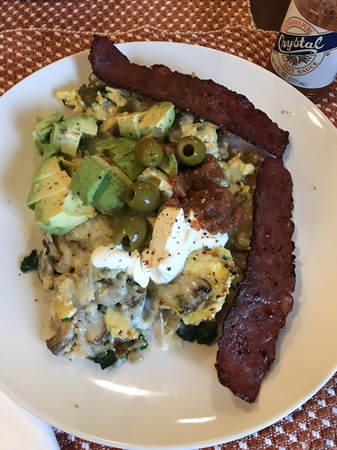 Brunch : Veggie and Egg Scramble Topped with Green Olives, Avocado, Sour Cream, Salsa and Hot Sauce Brunch : Veggie and Egg Scramble Topped with Green Olives, Avocado, Sour Cream, Salsa and Hot Sauce The Good This way of eating and focusing my nutrition continues to be beneficial. I have seen this in many respects in my own life as well as with my fiancé and others that I’ve seen undertake this way of eating. Reduced Number Of Meals Needed Eating nutrient dense food as well as adapting to using fat for fuel allows me to eat less meals, usually 2 per day, which makes life easier. Saved Time Reduced time spent dealing with food and or cooking is a huge bonus that I really enjoy, especially on those really busy days when I can choose to skip a meal without problems like loss of energy or focus. Reduced Body Fat I am able to maintain low body fat while keeping high energy and not having to worry about fat gain. My body fat percentage continues to remain low at 7.7% keeping me in the healthy range for this measure. Continued Muscle Gain I am able to make continued progress with conditioning as well as strength and muscle gain. My energy stays up for intense weightlifting and High Intensity Interval Training. Also, I gained 5.4 lbs of lean muscle over this past year. Improved Stomach and Digestive System This has been one of my biggest challenges throughout my life of always dealing with indigestion and a overall sensitive digestive system. I have much more control and consistency with my digestion especially after increasing my fiber intake and fermented foods such as sauerkraut. 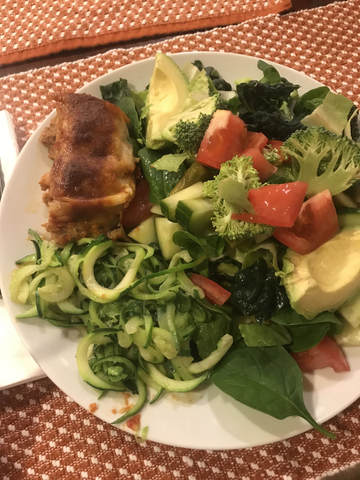 Dinner : Homemade Meatloaf with Grass Fed Beef, Spiralized Zucchini, and Salad with Avocado Dinner : Homemade Meatloaf with Grass Fed Beef, Spiralized Zucchini, and Salad with Avocado The Modifiers Restaurants A few things I should mention as the way that I approach my nutrition could very well be different than many others. Based on my current lifestyle, schedule and daily obligations, I rarely ever eat out at restaurants and therefore have almost 100% control of the food that I eat. This is mostly because of the quality of food is better and I get to choose all the ingredients that I have in my meals including the cooking oils and temperatures my food is being heated to. Many substitutions could be made at restaurants, though this is not something that I do myself often. Intermittent Fasting This is been one of the key components for me as part of this way of eating and nutrition. Having the ability to not eat breakfast most days as well as sometimes skip lunch on days that I need to for scheduling reasons or simply to give my digestive system more of a break. This has added significant value to this way of eating for me. Conclusion My Current Status/Perspective Starting 2 years ago, I have continued to eat this high fat, moderate protein, low carbohydrate diet and in the past year I have gained 6 pounds, 5 of which are lean muscle and 1 pound of body fat according to hydrostatic body weight measurement. I also experienced 2 unfortunate injuries over this past year which did complicate and cause me to miss strength training and conditioning for a few months. But despite this, I have continued to make progress with my overall strength and conditioning and believe that’s because of my diet and nutrition. I continue to see value in this way of eating and encourage anyone with an interest in improving their health to, at minimum, educate themselves to the different ways of getting your nutrition. Then to try and do research to figure out which may be the best for you. Again, this diet is in no way shape or form the best or only diet for everybody. In fact, it is worth repeating that I don’t believe there is one diet for everybody. Instead, there are principles and insights that we can understand and learn and try to implement in our own approach to eating. Follow this up with self experimentation and trial and error. If something is not working for you, then look further for other options or ways to approach this issue. Whether you’re trying to gain muscle, lose fat, reduce inflammation, or whatever your goal is, there are different ways of eating that can help support you and finding which one fits you best is key.  Some tempting sugar laden junk food. Some tempting sugar laden junk food. Positive and Negative Effects I've Noticed So Far It is always interesting to see what personal experience can show you as you adapt to a new diet or dietary adjustment. Also, how much this can differ from one person to the next and how you can find a system that will work for you. Therefore, these are not necessarily what you will experience if you were to eat the same way as I have. Even with my girlfriend and, I whom I live with and share most of my meals with, has had some experiences that are slightly different than myself. Positive -During the first week of adding Bulletproof high fat coffee to my breakfast, I soon become too full to have coffee and breakfast food, and have since done the high fat coffee or tea only. -I started loosing my craving for additional caffeine in the late morning or after lunch throughout the first 1-2 weeks. I used to drink 2-4 cups of coffee throughout the day. -I have more steady energy throughout the day and don’t feel a crash after lunch. -I am more in-tune with my hunger or often times lack of hunger, and don’t feel like I HAVE to eat all the time or even at typical “meal times”. -I can skip an occasional lunch without any feeling of irritation and often times without even any hunger pains. -I stay full longer from meals and therefore rarely ever snack. -I only have to eat 2 times per day, since I have bulletproof coffee or tea in the morning and have 2 larger meals for lunch and dinner. I usually don't get hungry until lunch which saves me time and hassle in the mornings. -I have lost bodyfat, which for me wasn’t the goal but is a great side effect (from about 8%-7%). Negative -I no longer eat the typical comfort foods, for me that was; chocolate chip cookies, pizza, sandwiches, ice cream, donuts, fries and others just to name a few. -It can be more difficult to eat out at restaurants, although I can usually skip the starch and order extra veggies to make a meal, at most places. -During the transition to higher fat, I added too much too quick a few times, which increased my need for bathroom trips, until I figured out the right dose for me and got used to eating this way. -I constantly have to remind myself to not worry about too much fat, but instead focus on not getting too much protein, which I used to think the more the better. -It does take a little more planning and foresight to avoiding getting yourself in a situation where you do not have the food you need. Although, because your body will be getting used to burning fat, you can always skip a meal and probably won’t be too hungry from this surprisingly. Additional Resources and Research Web: Ketogenic-diet-resource.com This is my go to website for easy to understand information regarding the ketogenic diet. Well written and full of great resources, check this site out! CharlieFoundation.org This website has great information and resources for current applications of ketogenic diet for therapy as well as links to research and research studies that are current and/or recruiting. Also, the blog has some great keto recipes. Books: Keto Clarity by Jimmy Moore This is a very in depth look at the Ketogenic diet and has many contributors including multiple MD's researchers and people that have been using the ketogenic diet for years. Eat Fat Get Thin by Dr Mark Hymman This is a well written explanation of why it is so important to get the right nutrients into your body and why lots of good fats is an important piece of this puzzle. Questions or Comments? Leave Me a Note Below! 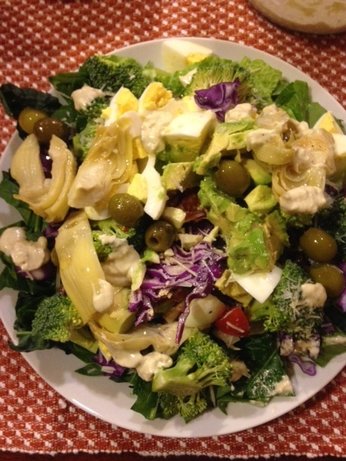 My "salad" which includes kale, spinach, lettuce, avocado, hard boiled egg, tomato, broccoli, cabbage, cheese, green olives, artichoke hearts, and sometimes bacon covered in homemade lemon vinaigrette dressing and MCT oil. My "salad" which includes kale, spinach, lettuce, avocado, hard boiled egg, tomato, broccoli, cabbage, cheese, green olives, artichoke hearts, and sometimes bacon covered in homemade lemon vinaigrette dressing and MCT oil. My Current Regimen And Personal Stats Over the past year of eating this high fat, moderate protein, low carb diet, I have found that certain foods and times of eating tend to work better for me than others. So far, for myself, this is what I have learned. I start out my day with the previously mentioned Bulletproof coffee or tea, which take the place of breakfast for me and allow my body to stay in a "fasting state" until lunch. For me, I drink my coffee/tea around 6am, after completing some morning routine items that includes my morning gut drink. (check out My Morning Routine Here). I will then workout and head to work where I will consume only water until lunch, which I eat at about 1:30pm. I don't snack because I don't get hungry between meals. The morning coffee/tea keeps me full until my lunch. Lunch consists mostly of leftovers from dinner the night before. This can vary, but usually includes a generous portion of “salad” and some small portion of protein and/or some hard cheese. Now, I should point out that when I say “salad”, this includes; kale, spinach, lettuce, avocado, hard boiled egg, tomato, broccoli, cabbage, cheese, green olives, artichoke hearts, and sometimes bacon covered in homemade lemon vinaigrette dressing and MCT oil. This is one of my go-to items and can be a stand alone meal, or with other times. This salad, which you can see covers most of my bases for nutritional needs, and tastes delicious. I will then head back to work until the evening when it is time to come home for dinner, around 7:30pm. This meal can vary a lot, but almost always includes a slightly scaled down version of my salad. Also, some sort of protein, which could be anything from burgers, to meatloaf to “reuben sandwiches”, chicken curry, stuffed chicken, pork shoulder, salmon, halibut, and many more. All of these recipes have been modified and made specifically for this diet, which is an important component of this food selection. One of the biggest differences from how I used to eat compared to how I am eating now is, smaller portions of protein with my meals. This can seem counter to what most people preach and is counter to what I did for a long time. I think it can be an important component of keeping your overall glucose levels down. This is to avoid protein to glucose conversion from having too much protein via gluconeogenesis. This can mean that even a low carb diet can be problematic if you have "too much" protein. 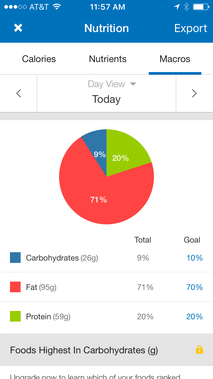 A sample meal macronutrient breakdown on myfitnesspal app. 70% Fat, 20% Protein, 10% Carbohydrates. A sample meal macronutrient breakdown on myfitnesspal app. 70% Fat, 20% Protein, 10% Carbohydrates. The tricky part with this is it seems to be different for everybody regarding how much protein is "too much". This can take some trial and error to figure out exactly how much protein your body needs, but I try to be around 20% of my daily total caloric intake, which tends to be around 100-150 grams of protein for me daily. This has been after lots of trial and error and is not aways perfectly exact. I also don't necessarily hit the same numbers everyday. I also didn't get to these numbers by measuring everything out first, and only eating what I calculated. I simply began by eating the amounts I was hungry for and felt that I needed and after a week or so of this, I would input the data into myfitnesspal which is a free app that will calculate your food intake calories, macronutrients and even micronutrients. After seeing where my numbers where at, based on my eating, I would adjust for usually less protein and more fat which is usually where I faltered. Through this process I learned more about the foods I was eating too, like how nuts can have more carbohydrates than I always thought. Keep in mind also, that I am about 160 lbs and workout most days including Crossfit and other HIIT workouts throughout the week. I have a very sensitive digestive system and am also NOT a competitive athlete. Therefore my nutritional goals, focus, and needs will most likely be different than yours. Make sure to always consult your physician or nutritionist before making any dietary changes. As previously discussed, the macronutrient ration goal of the ketogenic diet is somewhere in the range of 70% Fat, 20% Protein, and 10% Carbohydrates. Now remember, this is the percentage of each macronutrient based on total calories (food intake) NOT percentage of volume of food. Remember, 1 gram of Fat is 9 calories, while 1 gram of Protein and 1 gram of Carbs are both 4 calories each. This means that it doesn't take as much volume of foods that are high in fat as it does for protein or carbs to make up the same number of calories. The way I think of it is that, if my plate is 3/4 vegetables (including avocado, olive oil and/or MCT oil), and the last 1/4 split between protein and fat, I will be good. The vegetables include much needed fiber, which is vary important when eating a high fat diet. The food tastes good and keeps me full, lean and full of energy. I'm not sure what else you could want in a nutrition plan. Stay Tuned for Part 5: Positive and Negative Effects I've Experienced  How I Got Started Eating High-Fat After hearing about the ketogenic diet from many different sources, I decided to dive in a little deeper and give this a try for myself. Some of these people included; my buddy Lee Welton, podcasters including Joe Rogan and Tim Ferriss as well as doctors like Dr. Hymman who wrote Eat Fat Get Thin. The “gateway drug” or Trojan Horse for me into the ketogenic diet was a delicious beverage known as Bulletproof Coffee. This, now famous coffee recipe by Dave Asprey which includes; high grade Bulletproof coffee beans, which is delicious and is third party tested for toxins and molds, grass-fed butter (like Kerrygold brand) and C8 caprylic acid MCT oil (sold as Brain Octane and comes from coconut oil). ALL OF THIS IS BLENDED TOGETHER, which is a very important step to ensure the fat and coffee are mixed together well for that delicious creamy taste. I started this with the knock-off recipe, where I used the coffee I had in the house (organic coffee from Costco), coconut oil and the Kerrygold grass fed butter. This was still a great cup of coffee, but definitely not the same as using the Bulletproof coffee beans and Brain Octane C8 caprylic acid MCT oil. At first, my girlfriend and I started adding this to our breakfast in the morning.  After about a week (maybe less), we had to stop eating breakfast AND coffee because we both kept getting so full that we ended up putting most of our breakfast in the refrigerator for later. One thing that we began to notice pretty immediately, was that we started getting hungry a lot later in the day, especially as we started adding more fat to our other meals in the day. With the Bulletproof Coffee and about two weeks of transition, I was then and am still now able to have this as my "breakfast", and I don't get hungry until lunch (about 1pm) or sometimes later. I now I will also do a green tea variation of the Bulletproof coffee, where I simply swap out green tea for coffee but keep the fat. After a few weeks of being consistent with my Bulletproof coffee or tea "breakfast", I began to work on some more fine-tuning of my diet. The next step for me was to adjust my other two meals, lunch and dinner, by increasing my fat intake. The nice thing about this is, I get to eat a lot of salad and vegetables and delicious high quality foods including; good quality hard cheeses, grass fed butter, avocado, green olives, coconut oil and more. Stay Tuned for Part 4: My Current Regimen and Personal Stats 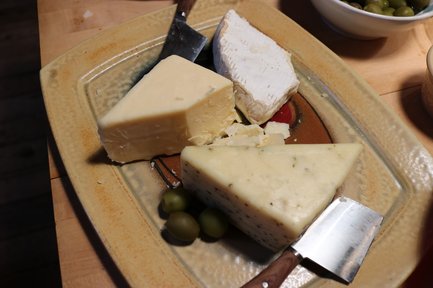 What Is The Ketogenic Diet? First off, it is important that you understand I am not a doctor, a dietitian, or nutritionist and am not advising on nutrition. I am simply sharing my experience and understanding through reading, listening, and lots of self experimentation. The material on this blog is for informational purposes only. As each individual situation is unique, you should use proper discretion, in consultation with a healthcare practitioner, before undertaking the protocols, diets, exercises, techniques, training methods, or otherwise described herein. The author and publisher expressly disclaim responsibility for any adverse effects that may result from the use or application of the information contained herein. My understanding of the ketogenic diet is that it was developed in the late 1920s for kids with epilepsy in which their seizures were uncontrollable with medication. "The ketogenic diet was designed in 1924 by Dr. Russell Wilder at the Mayo Clinic. Despite being highly effective in treating epilepsy, it fell out of fashion due to the surge in new anti-seizure medications in the 1940s. In 1994 Charlie Abraham’s family started The Charlie Foundation after his complete recovery from daily seizures despite trying all available anti-seizure medications and enduring a futile brain surgery. Charlie started the diet as a toddler and remained on it for 5 years. He is now a college student and remains seizure-free." www.CharlieFoundation.org Through research, they found that when these kids fasted, they no longer had seizures. Since you can't fast a kid or any human for that matter indefinitely, they began to develop a diet that mimics fasting physiologically, in order to provide the kids a way to avoid seizures, but still give their bodies the nutrients they need to survive. This was the ketogenic diet which is defined as make a diet with the macronutrient ratio of 70-75% fat, 20-25% protein, 5-10% carbohydrates. -ketogenic-diet-resource.com (These ratios can shift slightly depending on your particular body type, and food history.) The diet gets its name from the fact that when you switch to a high fat, moderate protein and low carb diet, your body begins to shift its main energy source away from glucose to ketone bodies, which come from fat and fat metabolism. When you are using these ketone bodies as your primary fuel source, you are said to be in ketosis, which can be tested a few different ways. This, at first glance, seems very extreme in a way, but I think after a little more explanation there will be some key points that make a lot of things clearer on this approach to nutrition. The first thing to remember, is that food volume and caloric density are different things. What I mean by that is, when you look at a plate of food, three-quarters of the plate should be covered by vegetables, with one-quarter remaining available for fat and protein. This can satisfy the proper ratio depending on the foods that are in those sections. One gram of carbohydrates is 4 calories one gram of protein is 4 calories one gram of fat is 9 calories. Therefore it takes less volume of fat to get the amount of calories that you need to satisfy the proper macronutrient ratio on this diet. So why is this important, and why the focus on eating such high fat? First of all, you need to have a basic understanding of how the body normally utilizes food for energy. On a typical American diet, your body takes the food that you've eaten and starts breaking it down to its smaller components through digestion. As it does this, it distributes the smaller parts of your food including glucose, to different parts of the body. Glucose specifically is taken from carbohydrates, sugar (and sometimes protein) and converted to energy (via ATP in the liver) then distributed to the bloodstream where it then gives you energy. Since our bodies are not perfectly precise, this increase in blood sugar can go higher than your normal concentration ( hyperglycemia) in which the body now needs to release insulin (a storage hormone) to manage and store this excess blood sugar for fuel to be used later as bodyfat. When this insulin is released and store this excess glucose, the blood sugar becomes lower than normal (hypoglycemia) and now your body begins to recognize this and begins to signal hunger to let you know that it needs fuel from more glucose, and the cycle continues. (You can read more about insulin at the American Diabetes Association). When your body releases insulin, more releases than needed to manage the current glucose levels, your blood sugar then drops which makes you hungry again. This is one mechanism that's acting on your energy levels when on a regular American diet. Another, is that of your hormones. When you eat carbohydrates you promote Ghrelin stimulation. A hunger hormone specifically hungry for that of glucose and carbohydrates. Conversely, when you eat fat, you stimulate Leptin production. This is a satiation hormone which allows you to feel more full and satisfied. Another nice effect of eating a high-fat, moderate protein and low carb diet is that because your body gets used to burning fat for fuel. It will then begin to also burn your body fat for fuel throughout the day and with diminished eating or low caloric intake. Another interesting point to consider for me was that there are some negative associations with metabolism of excess glucose and carbohydrates. In general, some of the these negatives include increased blood sugar, increased need for insulin and the excess storage of adipose (fat) tissue from this. Also, these foods take away space that could be used for more nutrient dense vegetables or high quality fats. These are foods that my body needs including the vitally essential building blocks to create and repair important tissue throughout my body and brain.
Stay Tuned For Part 3: How I Got Started Eating High Fat  My Food Story About 4 years ago, I was in school studying physical therapy. My life was full with studying, working as a personal trainer, working as a physical therapy aide and trying to manage all the stresses of life. I continued to finding myself with constant stomach problems that I attributed to stress at the time. These symptoms could range from day to day, but would be generally a combination of; upset stomach, increase bathroom trips, poor sleep quality, and trouble eating many types of food because they would increase these symptoms. I've always been into learning about health and nutrition and have mostly tried to eat foods that I thought were the healthiest for me. I've also been involved in sports as well as weight lifting and would try to match my eating with my fitness goals. This would include items you see typically in a “healthy” diet for most Americans who are trying to eat “healthy”. I was focused on getting enough carbohydrates to have energy for activities, enough protein to support my muscles and some fat to balance all of this out. I took a very similar approach to the very familiar Food Pyramid. 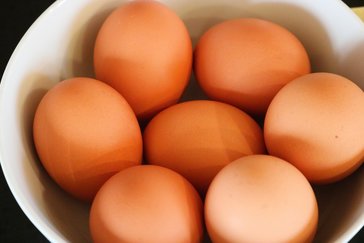 Some typical foods for me include, sandwiches, salad, chicken breast, eggs, broccoli and hummus, chips with beans and salsa, and multiple protein shakes throughout the week. I would fluctuate between trying to eat every 3 hours to just eating at the 3 meal times of breakfast, lunch and dinner. I also have struggled at times with cravings for sweets, mostly chocolate, ice cream and cookies as these were plentiful in my household growing up. And to be clear, I would not only indulge these cravings but would go to the extreme of eating so much of these foods that I would make myself sick that night and often times into the next day. I have been known in the past to eat an entire half gallon of ice cream in one sitting. This may be hard to believe for many of you but those who have lived with me in the past can attest to this unfortunate fact. Other than this, I would have the occasional burger and fries or fast food meal, but those were not daily occurrences. I finally started to try the elimination style dieting, where I would eliminate suspect foods that I think may be causing some problems, and then after a few weeks, try reintroducing them one at a time to see, if in fact this food did cause a problem. I tried this with dairy and with wheat, and found out some very interesting things. Both of these for me are problematic, but in different ways and to a much different degree than each other. I find that for dairy, as I used to drink lots and lots of milk, milk was actually one of the biggest problems. But, butter, cheese and eggs all seem to be fine. As for wheat, I found this to be very problematic to the point where I have tested myself after months of not eating this and within 15 minutes of eating an english muffin, I was in the bathroom. I have also found that other grains although not as problematic, tend to affect my stomach and can cause some digestive problems including; corn and to a lesser degree rice. So, after figuring out which foods I know I should not be eating, I started to adjust my diet in a way that made me feel much better, but still left me with some lingering problems. I would oftentimes go from being slightly under what I needed for total food intake for the day, to taking jumps over what I needed by eating too much late-night dark chocolate and peanut butter, cookies and ice cream, which are my kryptonite. Then, I started hearing about this idea of the ketogenic diet which is a diet that is high in fat, moderate protein and low carbohydrates. This made me start thinking about my own fat consumption and realized that I had a very low fat diet. I used to think this was good but after reading and understanding more about food nutrition and biology, I understood that our bodies desperately need good quality fats for so many of the physiological processes that are going on, as well as for repairing tissue, such as nerve tissue and brain tissue. The more I learn about this, the more my view about nutrition has shifted. I have now been eating a modified (slightly more protein) ketogenic diet for about a year now and have never felt this good before in my life!
Stay tuned for Part 2: What Is The Ketogenic Diet? Where I discuss my understanding of the Ketogenic Diet  If you look at most successful people, one major thing they have in common is that they think about their time differently. This is seen most often when looking at successful people's morning routines. One thing that seems to be almost a rule across the board, is that successful people wake up early. I believe it is not just about getting up early that allows you to be successful, it's about using that extra time that you create for yourself, to be productive for yourself. This, is why I think it's important that you optimize your mornings and figure out a routine that works best for you. There is a great quote by Jim Rohn, which says, “Learn to work harder on yourself than you do on your job”. I believe that waking up early with the intent to work hard on yourself first, before you get started on your job is what will start to set you apart from others. There is a lot of value in finding routines in general, especially because most of our days are made up of routines whether we choose them or not. If you think about the variety of food that you eat over a month, you tend to see that there is not much variety at all. You often get in a routine which is the result of default decision making that is based on what you did yesterday or the week prior. This default “decision” takes place of an actual decision rather than taking a step back and looking at all of the available options and reasons why you may choose one thing over another. Now, looking at your whole life this way can be daunting at first. This is why I think it's important that you take one aspect at a time to try and optimize. Practice that for a while until you become really good and consistent at that modification, then add the next step in. For me, the first thing I have been trying to optimize has been my morning routine. This has been my current morning routine for the past 10 months. The more days that I am consistent with my routine, the happier I become and the easier it gets. Most of these things that I'm about to talk about, I started about 10 months ago. There has been a few additions lately though, that I think are very valuable and will talk about those as well. My morning starts at 5 a.m. when I am gently awaken by a progressive sun simulating light, The Philips Wake Up Light. This light does a great job to wake me up, which has surprisingly been a nice change to the blaring radio alarm. This even feels like an upgrade from having a vibrating wristband like the Fitbit or Microsoft Band, which was my prior method of awakening. The light has a nice subtle way of letting you know that it's time to get up, without a physical or audible jolt first thing in the morning. For me, this removes the feeling of being stressed out as soon as I wake up. Once I am up out of bed, my body tells me that I need to use the restroom. I believe this is partly because our physiology becomes influenced by our routines, therefore our body knows the signaling of when to do things like the restroom. Also, I tend to eat dinner that includes high dietary fat content. This has an added benefit of keeping me regular, (ie consistent bathroom usage) and the morning time tends to be when that all gets resolved. While I’m using the restroom, I start our Infrared Sauna, to allow it to warm up to our current temperature of 140 degrees fahrenheit. 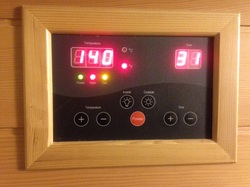 I sit in the sauna with my girlfriend for 30 minutes every morning. During this morning sauna, it is a great opportunity to practice breathing techniques. Specifically, diaphragmatic breathing and Wim Hof breathing, which are two breathing techniques that I've been utilizing more and more to try and minimize stress responses during activities. This has also helped me to have better control over my agitation and bouts of anxiety. This is also an opportunity for my girlfriend and I to write in our morning 5 Minute Journal. This has been a great part to the start of our day with purposeful thinking and a clear direction to focus on after leaving the sauna. We then have a traditional morning beverage that consists of, half of a lemon squeezed in a glass with about 1 to 2 tablespoons of apple cider vinegar, and filled about halfway up with cold water. 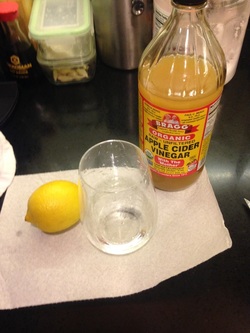 I have nicknamed this my morning “Gut Drink” and there are many reasons why I choose this to start my day. Most of all, it just helps me to feel energized and feel better throughout my day. After my morning Gut Drink, we have either tea or coffee. Lately, we have been drinking tea during the week and coffee on the weekends. This has been a nice schedule and makes me look forward to the mornings for this delicious drink. Our coffee is Bulletproof Coffee and yes we use the Bulletproof brand coffee beans. With this being said, it is important to mention that being a bit of a coffee snob and living in Seattle, I have ample choices of tasty coffee. I have also worked at a coffee shop and done many coffee tastings in the past. With all of this coffee experience I can honestly say that this is one of the best, if not the best tasting coffee I have ever had. There are also the added benefits of being third-party tested for toxins and molds. I believe this is worth the investment, especially if you rotate it with tea or other beverages throughout your week. Also, if you are only are drinking one cup of this per day, I believe it is worth the cost.  Other important components of our morning tea or coffee include, 1 tablespoon of Kerrygold grass-fed butter and lately we've been adding about a half a tablespoon of coconut oil and a half a tablespoon of Brain Octane C8 MCT oil. This is a full-fat beverage that allows both myself and my girlfriend to stay satiated and energized well through the morning until lunch time. After the coffee/tea is consumed depending on the day I make my way to the gym for a workout the specifics of the workout change Daily but they do always consist of positions and movements that take my body through ranges of motion that I don't get at my job or throughout the rest of my day my workouts last anywhere from 20 minutes to 45 minutes then I have some time to read right and think. I finish up whatever else I need to before heading to the shower to get ready for work. While I'm showering, I begin with nice warm water and slowly bring the temperature down as I’m working my way through my shower. I finish with cold water where I also focus on breathing which helps me to tolerate the cold. While brushing my teeth, I keep a Phillips Go Light on my counter which gives me the a bright blue light. I have found this to be helpful to fully awaken in the mornings, especially in the fall and winter in Seattle, where it can be dark most of the day. After all of this, I am now ready to face the day! |
Author : Jordan ProudfootHere are my thoughts and insights into fitness and wellness to be the best you possible. Archives
February 2019
Categories
All
|

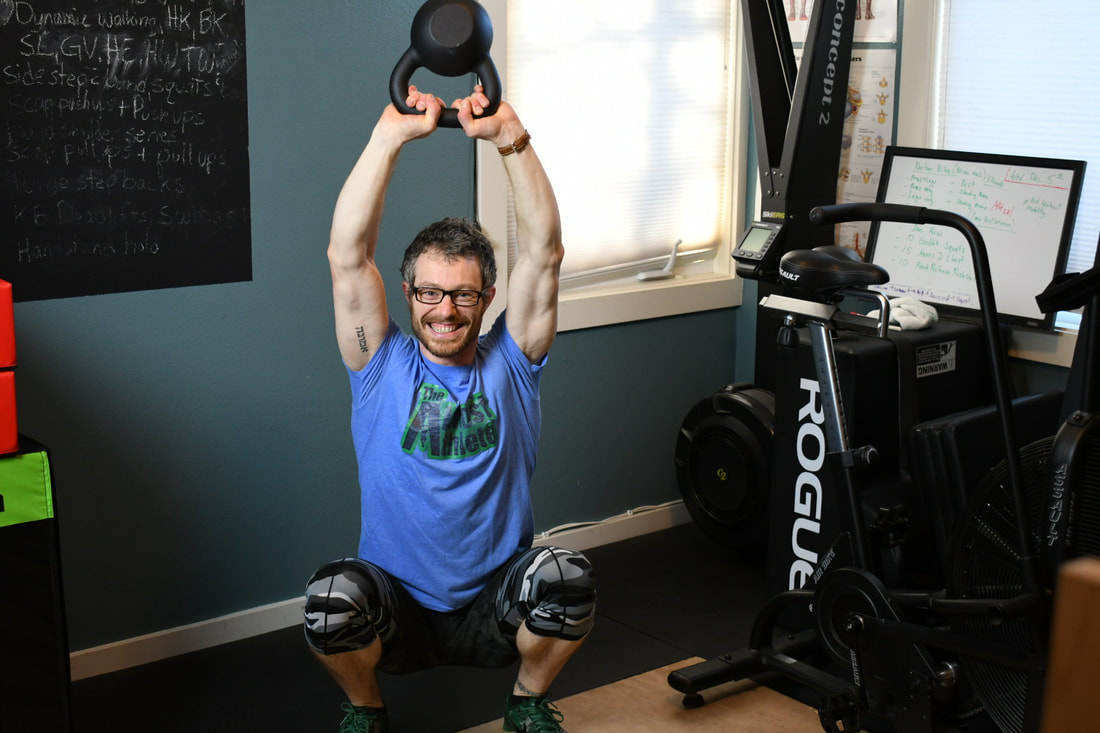

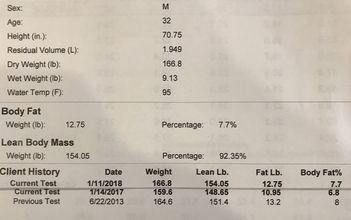
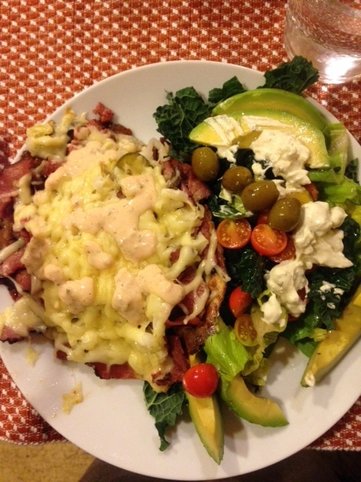
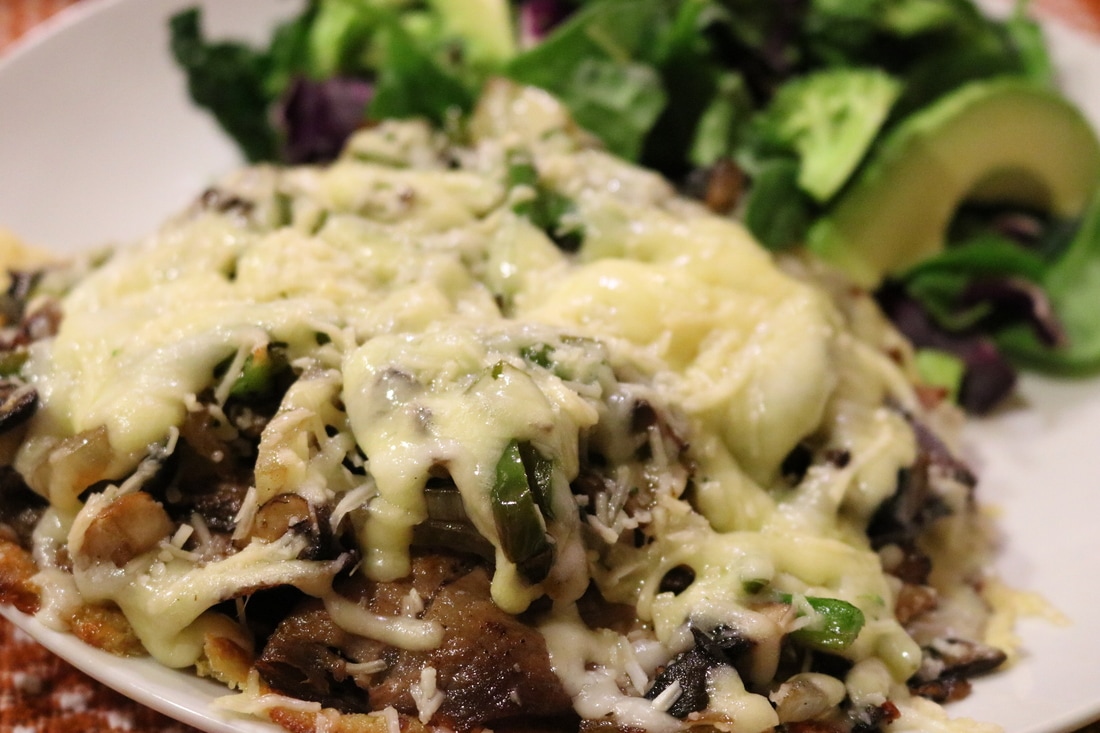





 RSS Feed
RSS Feed
